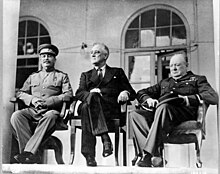Allies of World War II | |||||||
|---|---|---|---|---|---|---|---|
| 1939–1945 | |||||||
| Anthem: United Nations on the March (unofficial) | |||||||
 A 1943 poster showing the flags of many of the members of the Allies, including the "Big Three"
The Big Three:
Full list | |||||||
| Status | Military alliance | ||||||
| Historical era | World War II | ||||||
| February 1921 | |||||||
| August 1939 | |||||||
| September 1939 – June 1940 | |||||||
| June 1941 | |||||||
| July 1941 | |||||||
| August 1941 | |||||||
| January 1942 | |||||||
| May 1942 | |||||||
| November–December 1943 | |||||||
| 1–15 July 1944 | |||||||
| 4–11 February 1945 | |||||||
| April–June 1945 | |||||||
| July–August 1945 | |||||||
| |||||||




The Allies, formally referred to as the United Nations from 1942, were an international military coalition formed during World War II (1939–1945) to oppose the Axis powers. Its principal members by the end of 1941 were the "Big Four" – the United Kingdom, United States, Soviet Union, and China.
Membership in the Allies varied during the course of the war. When the conflict broke out on 1 September 1939, the Allied coalition consisted of the United Kingdom, France, and Poland, as well as their respective dependencies, such as British India. They were joined by the independent dominions of the British Commonwealth: Canada, Australia, New Zealand and South Africa. Consequently, the initial alliance resembled that of the First World War. As Axis forces began invading northern Europe and the Balkans, the Allies added the Netherlands, Belgium, Norway, Greece, and Yugoslavia. The Soviet Union, which initially had a nonaggression pact with Germany and participated in its invasion of Poland, joined the Allies after the German invasion of the Soviet Union in June 1941.[1][failed verification] The United States, while providing some materiel support to European Allies since September 1940, remained formally neutral until the Japanese attack on Pearl Harbor in December 1941, after which it declared war and officially joined the Allies. China had already been at war with Japan since 1937, and formally joined the Allies in December 1941.
The Allies were led by the so-called "Big Three"—the United Kingdom, the Soviet Union, and the United States—which were the principal contributors of manpower, resources, and strategy, each playing a key role in achieving victory.[2][3][4] A series of conferences between Allied leaders, diplomats, and military officials gradually shaped the makeup of the alliance, the direction of the war, and ultimately the postwar international order. Relations between the United Kingdom and the United States were especially close, with their bilateral Atlantic Charter forming the groundwork of their alliance.
The Allies became a formalized group upon the Declaration by United Nations on 1 January 1942, which was signed by 26 nations around the world; these ranged from governments in exile from the Axis occupation to small nations far removed from the war. The Declaration officially recognized the Big Three and China as the "Four Powers",[5] acknowledging their central role in prosecuting the war; they were also referred to as the "trusteeship of the powerful", and later as the "Four Policemen" of the United Nations.[6] Many more countries joined through to the final days of the war, including colonies and former Axis nations. After the war ended, the Allies, and the Declaration that bound them, would become the basis of the modern United Nations;[7] one enduring legacy of the alliance is the permanent membership of the U.N. Security Council, which is made up exclusively of the principal Allied powers that won the war.
- ^ "Milestones: 1937–1945". Office of the Historian. Archived from the original on 22 September 2023.
- ^ Johnsen, William T. (2016). The Origins of the Grand Alliance: Anglo-American Military Collaboration from the Panay Incident to Pearl Harbor. University Press of Kentucky. ISBN 978-0-8131-6836-4.
Although many factors manifestly contributed to the ultimately victory, not least the Soviet Union's joining of the coalition, the coalition partners' ability to orchestrate their efforts and coordinate the many elements of modern warfare successfully must rank high in any assessment.
- ^ Cite error: The named reference
:3was invoked but never defined (see the help page). - ^ Lane, Ann; Temperley, Howard (1996). The Rise and Fall of the Grand Alliance, 1941–45. Springer. ISBN 978-1-349-24242-9.
This collection by leading British and American scholars on twentieth century international history covers the strategy, diplomacy and intelligence of the Anglo-American-Soviet alliance during the Second World War. It includes the evolution of allied war aims in both the European and Pacific theatres, the policies surrounding the development and use of the atomic bomb and the evolution of the international intelligence community.
- ^ Hoopes, Townsend, and Douglas Brinkley. FDR and the Creation of the U.N. (Yale University Press, 1997).
- ^ Doenecke, Justus D.; Stoler, Mark A. (2005). Debating Franklin D. Roosevelt's Foreign Policies, 1933–1945. Rowman & Littlefield. ISBN 978-0847694167.
- ^ Ian C. B. Dear and Michael Foot, eds. The Oxford Companion to World War II (2005), pp. 29, 1176